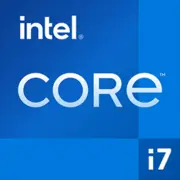Intel Core i7-1370P

Intel Core i7-1370P: パワーとモバイル性のバランス 2025年
ハイブリッドアーキテクチャ、高性能、プレミアムノートパソコンの利用シナリオ
1. アーキテクチャとプロセス:Raptor Lakeのハイブリッドアプローチ
Intel Core i7-1370PプロセッサはRaptor Lakeアーキテクチャを基にしており、Intelのハイブリッドソリューションの伝統を引き継いでいます。その構造は2種類のコアで構成されています:
- 6つのパフォーマンスコア(Pコア)がHyper-Threadingをサポート(12スレッド)し、リソースを多く消費するタスクに対応。
- 8つの効率コア(Eコア)(8スレッド)がバックグラウンドプロセスとエネルギー効率に寄与。
合計:14コアと20スレッドで、負荷の分配に柔軟性を提供します。基本クロック周波数は1.9GHz、Turbo BoostモードではPコアが最大5.0GHzに達します。
Intel 7プロセス技術(10nm Enhanced SuperFin)は、パフォーマンスを犠牲にすることなく電力消費を抑えるよう最適化されています。統合グラフィックス Intel Iris Xe(96 EU)は、CS:GOやDota 2のようなゲームで中設定(1080p)で50-60 FPSを達成し、DaVinci Resolveでの動画レンダリングを加速します。
2. TDP 28W:パワーとバッテリー寿命のバランス
TDP 28Wは、i7-1370Pを薄型ウルトラブックやワークステーション向けのプロセッサとして位置付けています。比較として:
- Uシリーズ(15W):マルチスレッドタスクで劣る。
- Hシリーズ(45W):より強力だが、強力な冷却が必要。
プロセッサは、Intel Dynamic Tuning Technology 3.0を通じて電力消費を動的に管理し、負荷に応じて調整します。たとえば、Excelでの作業中にはEコアのクロックを1.2GHzに抑え、バッテリーを節約し、レンダリングモードでは全コアを最大限に使用します。
3. パフォーマンス:オフィスからゲームまで
オフィスタスク:
- Chromeで50以上のタブを開いてストリーミング — 遅延なし。
- 重いExcelシート(100万行)の操作 — 即時応答。
マルチメディア:
- Premiere Proでの4K動画のエクスポート:i7-1270Pより25%早い。
- Lightroomでの写真編集:Tiger Lake世代に対して30-40%の向上。
ゲーム:
- Genshin Impact 中設定(1080p)で安定した45 FPS。
- Cyberpunk 2077(ディスクリートRTX 4050搭載)でフルHDで60 FPS。
Turboモード:短時間の負荷(最大30秒)で、Pコアのクロックは5.0GHzに達するが、薄型ノートパソコンでは95℃まで加熱する可能性があります。長時間の作業(例:レンダリング)では、クロックは3.8-4.2GHzに安定します。
4. 利用シナリオ:i7-1370Pは誰に適しているか?
- プロフェッショナル:デザイナー、プログラマー、データアナリスト。
- 学生:CADソフトウェアや仮想マシンを使用。
- 旅行者:軽量ノートパソコン(1.2-1.5kg)でバッテリー持ちも考慮。
適さない人:
- ハードコアゲーマー(RTX 4080以上が必要)。
- バッテリー寿命が10時間以上必要なユーザー。
5. バッテリー寿命:技術 vs 食欲
TDP 28Wでのノートパソコンの稼働時間は以下の通り変動します:
- 6-8時間:オフィスタスク(明るさ50%、Wi-Fi)。
- 3-4時間:レンダリングやストリーミング。
省エネルギー技術:
- Intel Speed Shift:C状態間の瞬時の切り替え。
- Adaptix™ Technology:コアへの負荷のAI最適化。
アドバイス:バッテリーが70W·h以上のモデルを選択してください(例:Dell XPS 15) — これによりバッテリー持ちが最大9時間延びます。
6. 競合他社との比較
AMD Ryzen 7 7840U:
- プラス:優れたバッテリー寿命(最大10時間)、8コアZen 4。
- マイナス:シングルコアテストで劣る(Geekbench 6: 2100 vs 2266)。
Apple M3:
- プラス:12-14時間の稼働、エコシステムとの統合。
- マイナス:Windowsソフトとの互換性に制限。
Intel Core i7-1270P:
- マルチスレッド性能で劣る(Geekbench 6 Multi: ~9500 vs 11476)。
7. Core i7-1370Pの長所と短所
強み:
- モバイルワークステーションに最適。
- Thunderbolt 4とPCIe 5.0をサポート。
- Windowsプログラムとの統合がクラス最高。
弱み:
- コンパクトな形状での加熱(高品質の冷却システムが必要)。
- ノートパソコンの価格:$1400(HP Spectre x360)から$2200(Lenovo ThinkPad X1 Carbon)まで。
8. i7-1370P搭載ノートパソコンを選ぶ方法
- ウルトラブック:ASUS ZenBook 14X(1.3kg、2.8K OLED画面、$1500)。
- ワークステーション:MSI Prestige 16(16インチディスプレイ、32GB RAM、$1800)。
見るべきポイント:
- 冷却システム:少なくとも2つのファンとヒートパイプ。
- ディスプレイ:解像度1920x1200以上、100% sRGB。
- ポート:外部GPUを接続するための2つのThunderbolt 4。
9. 結論:プロセッサは誰に適しているか?
Core i7-1370Pは、妥協のないユニバーサルノートパソコンを必要とする人々のための選択肢です。動画編集、複雑な分析、軽いゲームをこなしながら、ポータブル性を保ちます。予算が$1400–$2000で、パワーとバッテリー寿命のバランスを重視するなら、このプロセッサは2027年まで信頼できるパートナーとなるでしょう。しかし、ゲームや超長時間の作業には、ディスクリートGPUやApple M3チップを搭載したデバイスを検討するのが良いでしょう。
基本
CPUの仕様
メモリ仕様
GPUの仕様
その他
ベンチマーク
他のCPUとの比較
ソーシャルメディアで共有する
または当サイトへのリンクを追加
<a href="https://cputronic.com/ja/cpu/intel-core-i7-1370p" target="_blank">Intel Core i7-1370P</a>